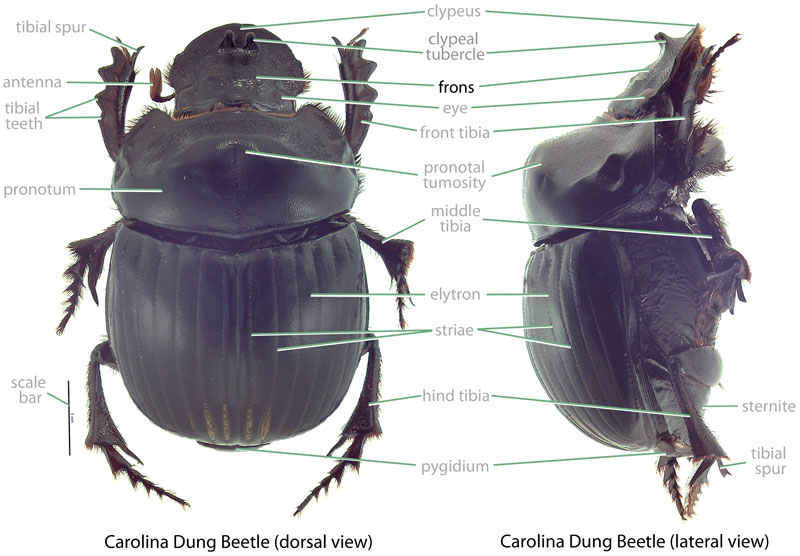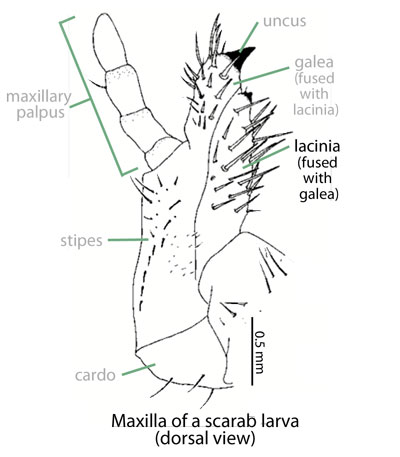Beneficial
Alexis dung beetle
Family: Scarabaeidae Subfamily: Scarabaeinae Genus: Onitis Species: Onitis alexis Klug, 1835
none available
Total body length 15.0–22.0 cm (0.59–0.86 in). Body shape subquadratesubquadrate:
somewhat quadrate in shape
posteriorly; may be caked in dried dung. Color of head and pronotumpronotum:
the dorsal surface of the thorax
 dark green to blackish-green. Clypeusclypeus:
dark green to blackish-green. Clypeusclypeus:
part of the head anterior to the frons; the most anterior portion in dorsal view
 weakly sinuatesinuate:
weakly sinuatesinuate:
gently curved (specifically of margins or edges); often in reference to the clypeus
or rounded. Fronsfrons:
part of the head generally positioned between the eyes (posterior to the clypeus and anterior to the vertex) and visible dorsally
 with weakly developed central tubercletubercle:
with weakly developed central tubercletubercle:
a small, conical knob or horn-like protuberance
; female tubercletubercle:
a small, conical knob or horn-like protuberance
comparatively larger than in male. Front tibiatibia:
a segment of the leg articulated with the tarsus and femur
 of male elongate, curving ventrally and inward at apexapex:
of male elongate, curving ventrally and inward at apexapex:
point or edge furthest from the body
; female tibiatibia:
a segment of the leg articulated with the tarsus and femur
 less elongate and curved than male; tarsitarsi:
less elongate and curved than male; tarsitarsi:
the distal part of an insect leg attached to the tibia and consisting of five sub-segments in scarab beetles; bears the tarsal claws
lacking in both sexes. Tibiatibia:
a segment of the leg articulated with the tarsus and femur
 of middle leg gradually expanded to a triangulate apexapex:
of middle leg gradually expanded to a triangulate apexapex:
point or edge furthest from the body
. Hind trochantertrochanter:
a segment of the leg articulated with the femur and coxa
lacking spine on posteriorposterior:
towards the rear end; opposite of anterior
margin in both sexes. Hind femurfemur:
segment of the leg that is articulated to the body by the trochanter and bears the tibia at the distal end
of male with well-developed, curved spine on posteriorposterior:
towards the rear end; opposite of anterior
margin; female lacking spine.
Undescribed. For Scarabaeinae (Ritcher, 1966Ritcher, 1966:
Ritcher P. 1966. White grubs and their allies: a study of North American scarabaeoid larvae. Oregon State University Monographs, Studies in Entomology 4: 1-219.): Grub C-shaped, hump-backed, cylindrical, cream-colored. Maxillamaxilla:
set of paired mouthparts located posterior to the mandibles
with galeagalea:
outer branch or lobe of the maxilla
 and lacinialacinia:
and lacinialacinia:
inner portion of the maxilla distinctly separate. Epipharnyx with tormaetormae:
distinctly separate. Epipharnyx with tormaetormae:
in scarab larvae, sclerotized structures on the ends of the clypeolateral suture extending towards the mesal line
united mesallymesally:
at or near midline of body
, anterioranterior:
the front or forward; opposite of posterior
phoba present. AntennaeAntennae:
paired sensory organ on head, formed from numerous segments
 with 4 or 5 apparent segments. Distaldistal:
with 4 or 5 apparent segments. Distaldistal:
situated away from the point of articulation, thus usually furthest from the body
segment of antennaantenna:
paired sensory organ on head, formed from numerous segments
 reduced in size. Legs 2-segmented. Anal opening surrounded by fleshy lobes.
reduced in size. Legs 2-segmented. Anal opening surrounded by fleshy lobes.
Africa and the Mediterranean. Onitis alexis is broadly distributed from Spain and Syria, southward to South Africa. It is, however, largely absent from the heavily forested areas of western Africa (Krikken, 1977Krikken, 1977:
Krikken J. 1977. Notes on African Onitini, mainly from southeastern Kenya (Coleoptera: Scarabaeidae). Zoologische Mededelingen: 141-170. full text (accessed 2015)).
None. Onitis spp. feed on dung as both adults and larvaelarvae:
the immature form of an insect; in scarabs, also called grub or white grub; preceded by the egg stage, followed by the pupal stage
 (Edwards and Aschenborn, 1987Edwards and Aschenborn, 1987:
(Edwards and Aschenborn, 1987Edwards and Aschenborn, 1987:
Edwards P and Aschenborn H. 1987. Patterns of nesting and dung burial in Onitis dung beetles: implications for pasture productivity and fly control. Journal of Applied Ecology 24: 837-851. full text (accessed 2015)).
This species inhabits savannahs, grasslands, and pastures where they are most active at dusk and dawn. Adults show a preference for the dung of large herbivorous mammals. The species is recorded feeding on elephant, cattle, and buffalo droppings (Krikken, 1977Krikken, 1977:
Krikken J. 1977. Notes on African Onitini, mainly from southeastern Kenya (Coleoptera: Scarabaeidae). Zoologische Mededelingen: 141-170. full text (accessed 2015)). Male-female pairs dig a dung-lined tunnel under a dung source to an average depth of 17 cm (6.7 in). The burrow is then stocked with 150–200 grams of dung, which is made into multiple sausage-like shapes. One to four eggs are deposited into each dung-sausage (Edwards and Aschenborn, 1987Edwards and Aschenborn, 1987:
Edwards P and Aschenborn H. 1987. Patterns of nesting and dung burial in Onitis dung beetles: implications for pasture productivity and fly control. Journal of Applied Ecology 24: 837-851. full text (accessed 2015)). The egg to adult lifecycle can be completed in as little as two months in the summer, but it may require over a year if conditions are poor. In good habitat, there can be several generations per year (Tyndale-Biscoe, 1990Tyndale-Biscoe, 1990:
Tyndale-Biscoe M. 1990. Common dung beetles in pastures of southeastern Australia. CSIRO Publishing, Clayton, Australia.). LarvaeLarvae:
the immature form of an insect; in scarabs, also called grub or white grub; preceded by the egg stage, followed by the pupal stage
 cannot survive cool, wet winters (Tyndale-Biscoe, 2006Tyndale-Biscoe, 2006:
cannot survive cool, wet winters (Tyndale-Biscoe, 2006Tyndale-Biscoe, 2006:
Tyndale-Biscoe M. 2006. The phenology of Onitis alexis (Coleoptera: Scarabaeidae) in the Araluen Valley: survival in a marginal environment. Australian Journal of Ecology 134: 431-443.).
None. This species recycles dung and is beneficial for ranching and farming in Hawaii. Being a dung feeder, this species poses no threat to crop or ornamental plants. Additionally, this species is not a threat to native dung beetles because none are known from Hawaii or Guam.
Established. This scarab was released in 1976 at Parker Ranch on Big Island where it is now established (Nakao and Funasaki, 1979Nakao and Funasaki, 1979:
Nakao H and Funasaki G. 1979. Introductions for biological control in Hawaii: 1975 amp; 1976. Proceedings of the Hawaiian Entomological Society 23: 125-128. full text (accessed 2015)). Like most of Hawaii's dung beetles this species was introduced to help control populations of the horn fly (Haematobia irritans), a biting pest of livestock.
Not established or recorded. There are no records of this species from Guam.
In Hawaii, this species was intentionally introduced.
Three species of Onitis are recorded from Hawaii (none are known from Guam). Onitis alexis is separated from the other Onitis species by examination of the middle tibiatibia:
a segment of the leg articulated with the tarsus and femur
 (O. alexis with middle tibiatibia:
(O. alexis with middle tibiatibia:
a segment of the leg articulated with the tarsus and femur
 gradually expanded to triangulate apexapex:
gradually expanded to triangulate apexapex:
point or edge furthest from the body
versus abruptly expanded to a trapezoidal apexapex:
point or edge furthest from the body
in O. phartopus), the hind trochantertrochanter:
a segment of the leg articulated with the femur and coxa
(O. alexis lacking a spine on the posteriorposterior:
towards the rear end; opposite of anterior
margin versus O. phartopus with well-developed spine in male), hind femurfemur:
segment of the leg that is articulated to the body by the trochanter and bears the tibia at the distal end
of the male (O. alexis with a curved femoral spine versus O. vanderkelleniwith straight spine, O. phartopus lacking a spine) and color (O. alexis dark green to blackish-green with brown elytraelytra:
the hardened and chitinous wing-cover of a beetle that protect and overlie the flight wing
versus color entirely dull black in O. vanderkelleniand O. phartopus).
Onitis africanus Gillet, Onitis aygulus Latreille, Onitis inuus Klug, "Onitis sphinx" of authors, Onitis tuberculatus Balthasar
Report your observation of this beneficial species at our iNaturalist project.